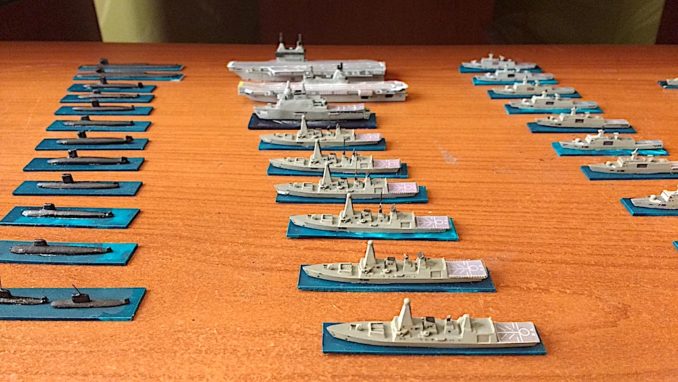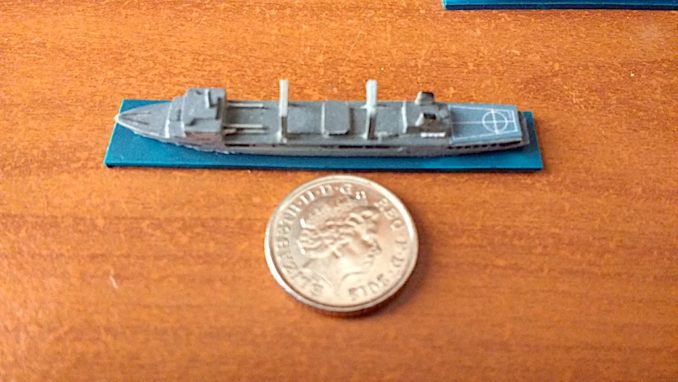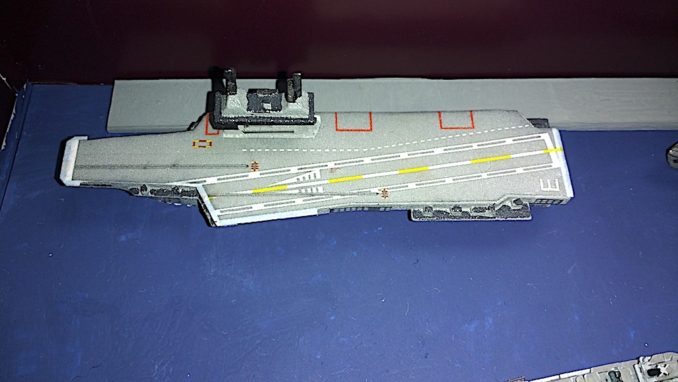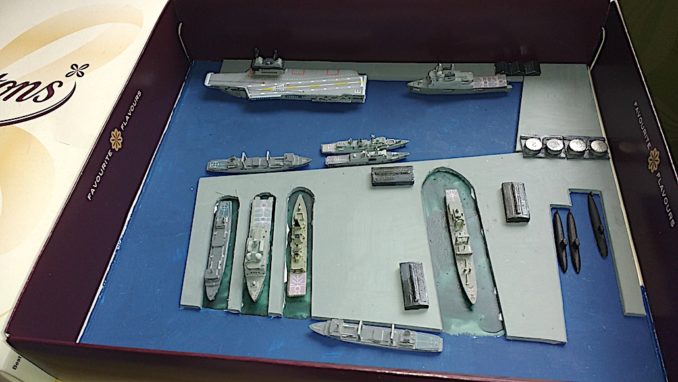Nelson reminded us it takes two years to build a frigate and two hundred years to build a tradition. The odd, the quirky, the eccentric fuels that tradition and provides the cement that bonds fellow adherents to each other and the past to the present. Her Majesty’s Embassy staff in Nairobi includes a century-old giant tortoise. He is as big as a coffee table. His presence has created more goodwill towards our mission than any end of Foreign Office initiatives.
My local regiment, following light pilfering after the battle of Salamanca, is in possession of Napoleon’s drums. Brought out on special occasions, they are paraded with a ceremonial axe of whose significance I know not. There are tales of Taliban terrorists’ prosthetic legs being used as drinking vessels on mess nights in faraway God forsaken sun scored desserts. Speaking of coffee tables, one understands bits of the Scharnhorst provide such a service in distant wardrooms.
Amongst the fine port and off-colour cutlery did Evelyn Waugh’s Sword of Honour trilogy Halberdiers have a collection of elephant’s feet? Perhaps they didn’t.
It is pointless pushing against such things. Totems, archetypes and symbols are powerful. They capture the imagination, refresh the soul and motivate the life force. It is human nature. One feels obliged to join in the oddness of it all and do bit of collecting.

© Always Worth Saying2022, Going Postal
Speaking personally, I’ve always had my own navy. Don’t mock. It has outlived the Soviet Union and lasted longer than Britain’s membership of the European Union. When I was small I had a collection of Airfix 1/600 plastic kits. Remember HMS Fearless, HMS Antelope, the Leander Class frigate and, the most handsome of warships, the County Class destroyer, immortalised by Airfix in the shape of HMS Devonshire? And an aircraft carrier, HMS Victorious, with its outsized 3D radar and complement of Sea Vixens and Scimitars.
Somewhat top heavy to start with, the capital ships threatened to outnumber the escorts with the addition of another carrier, USS Hornet, the 1:1 scale version of which launched the first Pacific War air raid on Japan.
My father helped, but only in providing visiting ships to take part in exercises. Referencing his own childhood, he preferred to build the likes of Warspite, Hood and Ajax. To differentiate the fleets, in peacetime my decks were painted an off ochre in the same way Mousillini might cover the Marina Militare in red and white diagonals.
As young men are wont, I determined to have the biggest navy in the world. Ronald Reagan’s commitment to five hundred hulls put an end to that. Five hundred and one 1/600 scale ships would not only bankrupt the piggy bank but laid end to end would stretch longer than a football pitch.
Not being the first to be outspent by the Americans, I determined instead to have the world’s second-biggest but best navy. A change of scale beckoned, 1/3000 being the one chosen.

© Always Worth Saying 2022, Going Postal
It only takes a few days a year of glueing, printing, painting and 3D modelling to keep things shipshape, at the end of which I have something to show for my efforts unlike spare time wasted watching football, drinking or anything involving those strange things known as other people.
In my modelling, I’ve found the best results come from a combination of available white metal models, painted and then embellished with inkjet printed and fine wire details.
Very fine mesh and the thinnest of brass wire can be chopped and superglued for radars and antennae. Inkjet printing on sticky white paper provides such things as helicopter decks and liferafts. Printing onto clear sticky labels provides other detail that can be cut out with a razor blade and applied to a hull, deck, or superstructure with the smallest pieces being applied from the end of a pin. The final step is to cover everything in matt varnish.
The trick is to do bit every now and again purely for fun. With planning and foresight, it’s surprising, looking back, how effortless it was to build up a reasonable fighting force.
The invention of 3D printing was a boon. Or was it? Yes, you can design your own vessels in Sketch-Up, upload them to Shapeways and pay to have them printed out and posted to you. Added to which, when other people use your designs you get a commission. But for the prices I’m prepared to pay, the printed surface is rough compared to white metal. From a distance and when painted and detailed, they look fine but close up they suffer.
My versatile carrier is one of my own designs via Shapeways as is my smaller ‘Harrier carrier’. The larger carrier was influenced by France’s Charles De Gaule, and the Harrier carrier by the American Tawara class, with a ramp on the front but, mistakenly, no dock on the back. An omitted competence made up for by my two Dutch LPDs, Rotterdam and de Witt.

© Always Worth Saying 2022, Going Postal
On Shapeways, I’ve found a generic design sells better than an attempt at a prototype of a real class of warship, with downloaders preferring to use their own imaginations when detailing additions to their own fleets.
At one point I made batches of what I wanted and sold the difference on eBay but it was an awfully fiddly business, more trouble than it was worth and not all of the batches would sell. Some spares could be added to my fleet. Two un-loved Type 23s came in handy for their anti-submarine warfare capability, but the rest of an eclectic collection sits in a box in the attic and are occasionally brought out for exercises, port visits or navy days.
My carriers require fleet air arms. 1/3000 aircraft would be too small so I use 1/1250 scale with one outsized model representing a squadron when placed on a flight deck. As well as F-35s painted different colours to differentiate between C’s (catapult-launched) and B’s (ramp take of and verticle landing) there are maritime reconnaissance and airborne warning and command and control fixed-wing aircraft and helicopters in addition to land-based transports for flying people, parts and supplies around my global bases.
For my navy is a blue water expeditionary force unafraid of Johnny foreigner, erupting volcanoes or ice flows. With at least one base bordering each of the world’s oceans, no matter what happens my grey funnel line has a good chance of getting there and making itself useful.
Indian Ocean Station is based is somewhere on the East Coast of Africa, I haven’t quite decided where. At the moment it is allocated a frigate (for chasing pirates) and an RFA for moving vitals about to benefit the impoverished and war-torn locals. Covering the Gulf too, IOS is presently a bit short-staffed.
In the Western Pacific, when the Americans left Subic Bay I moved in. The dry docks are handy. Cheap labour and all that. My Ro-Ro ferry is being repaired there after I dropped it and the masts broke off. In the Eastern Pacific, the Americans allow me a pier in San Diego. In the Med, the RN are equally generous with a birth at Gibraltar. Meanwhile, on the Atlantic seaboard, I bought a tract of British Guiana (West Indies Station) from an impoverished sugar planter, flooded it and built a port.

© Always Worth Saying 2022, Going Postal
In the South Atlantic, I prefer out of the way Grytviken to cosmopolitan Port Stanley but have nothing down there at the moment. When I get around to it, I shall paint an old frigate red, glue some ice-breaking quarter millimetre plasticard to the bow, add a crane to the flight deck and send it South.
Is this odd to the point of being frightening?
Not at all. Two important truisms emerge. Everybody needs a hobby and other people’s hobbies are always a bit strange. Try explaining fishing (wade into the wet with a stick and hook, catch something and let it go) or stamp collecting (because somebody’s licked it, peel it off with the help of a steam kettle) to an alien. But they have a utility beyond enjoyment. There are hobbying skills that are transferable to that less interesting thing known as the real world.
Coordination between the eye and the hand. Planning and assembling components. Deciding upon required competencies and discerning between them with limited resources. Attention to detail. Researching the vessels. The importance of getting it right first time, every time. All this is handy practice for innumerable real-life home and workplace scenarios.
The American Association of Retired People adds that our brains love the associated work, model making gets you interested in history and modeller’s conventions, competitions and clubs provide for an enjoyable and healthy social life. Collectables manufacturers DeAgostini remind us of skills development and the benefits of stress relief,
Scale modelling is a hobby that is tailor-made to relieve your stresses. A couple of hours spent piecing together or painting your model can clear your mind of the problems of the world, and leave you in a calmer state than when you began.
DeAgostini also inform us that your completed models provide a trophy collection that gives a tangible sense of reward, self-esteem and personal achievement. Not to mention a chance to appoint oneself the First Sea Lord and Chief of Naval Staff of the best little navy in the world!
© Always Worth Saying 2022



